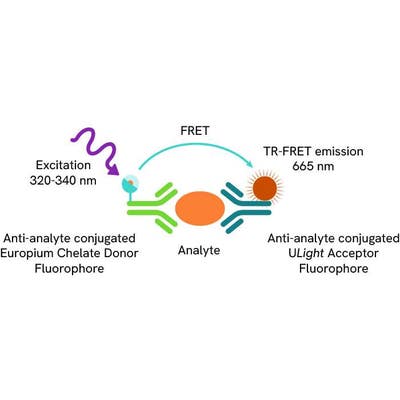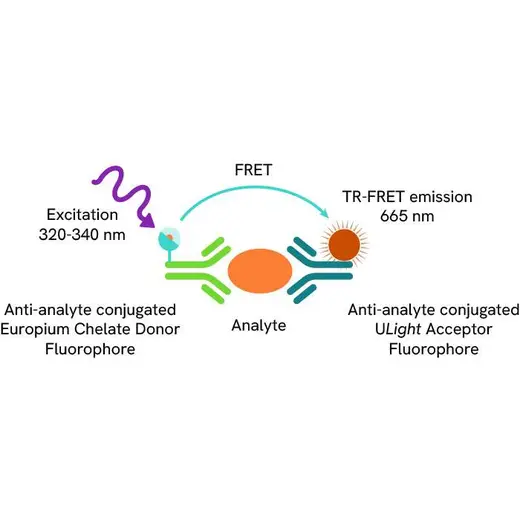
LANCE Ultra Human CCL2 Detection Kit, 500 Assay Points

LANCE Ultra Human CCL2 Detection Kit, 500 Assay Points




The LANCE® Ultra Human CCL2/MCP-1 Detection Kit is designed for detection and quantitation of human CCL2/MCP-1 in cell culture media using a homogeneous TR-FRET (no-wash steps, no separation steps) assay.
| Feature | Specification |
|---|---|
| Application | Protein Quantification |
| Dynamic Range | 11.4 - 10,000 pg/mL |
| Limit of Detection | 11.4 pg/mL |
| Limit of Quantification | 51.7 pg/mL |
| Sample Volume | 15 µL |
The LANCE® Ultra Human CCL2/MCP-1 Detection Kit is designed for detection and quantitation of human CCL2/MCP-1 in cell culture media using a homogeneous TR-FRET (no-wash steps, no separation steps) assay.


LANCE Ultra Human CCL2 Detection Kit, 500 Assay Points


LANCE Ultra Human CCL2 Detection Kit, 500 Assay Points


Product information
Overview
The LANCE Ultra Human CCL2/MCP-1 Detection Kit is designed for detection and quantitation of human CCL2/MCP-1 in cell culture media using a homogeneous TR-FRET (no-wash steps, no separation steps) assay.
The 500 point kit contains enough reagents to run 500 wells in 384-well format, using a 20 µL reaction volume (15 µL of sample). The 10,000 point kit contains enough reagents to run 10,000 wells in 384-well format, using a 20 µL reaction volume (15 µL of sample).
- No-wash steps, no separation steps
- TR-FRET technology
- Sensitive detection
- High reproducibility
- Faster time-to-results
- Easy automation
- 96-well, 384-well, and 1536-well formats
LANCE and LANCE (Lanthanide chelate excite) Ultra are our TR-FRET (time-resolved fluorescence resonance energy transfer), homogeneous (no wash) technologies. One antibody of interest is labeled with a donor fluorophore (a LANCE Europium chelate) and the second molecule is labeled with an acceptor fluorophore (ULight™ dye). Upon excitation at 320 or 340 nm, energy can be transferred from the donor Europium chelate to the acceptor fluorophore if sufficiently close for FRET (~10 nm). This results in the emission of light at 665 nm.
C-C motif chemokine 2 (CCL2) or Monocyte Chemoattractant Protein 1 (MCP1) contains 76 amino acids and is glycosylated after complete processing. CCL2 is part of the CXC subfamily of cytokines. Fibroblasts, tumor cells, smooth muscle cells, endothelial cells, and mononuclear phagocytes can produce CCL2 either constitutively or upon stimulation. CCL2 displays chemotactic activity for monocytes and basophils, but not for neutrophils or eosinophils. It also regulates adhesion molecule expression and cytokine production in human monocytes. CCL2 has been implicated in the pathogenesis of diseases characterized by monocytic infiltrates, like psoriasis, rheumatoid arthritis and atherosclerosis. CCL2 is considered as an important biomarker in cardiovascular diseases.
Specifications
| Application |
Protein Quantification
|
|---|---|
| Automation Compatible |
Yes
|
| Brand |
LANCE Ultra
|
| Detection Modality |
LANCE
|
| Dynamic Range |
11.4 - 10,000 pg/mL
|
| Limit of Detection |
11.4 pg/mL
|
| Limit of Quantification |
51.7 pg/mL
|
| Product Group |
Kit
|
| Sample Volume |
15 µL
|
| Shipping Conditions |
Shipped in Blue Ice
|
| Target |
CCL2
|
| Target Class |
Cytokines
|
| Target Species |
Human
|
| Technology |
TR-FRET
|
| Therapeutic Area |
Inflammation
|
| Unit Size |
500 Assay Points
|
Resources
Are you looking for resources, click on the resource type to explore further.
Emerging pathways to neuroinflammation and neurodegeneration
Neurodegenerative diseases, such as amyotrophic lateral sclerosis...
LANCE™ Ultra TR-FRET is a no-wash proximity assay technology that combines the benefits of time resolution (TR) with fluorescence...


How can we help you?
We are here to answer your questions.






























